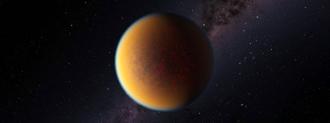The atmosphere a planet is “born” with doesn’t have to be its last — Earth is on its third version of an atmosphere.
The first was likely made of the same gases as the sun, but those eventually escaped the planet’s gravity and were replaced by an atmosphere made of steam, carbon dioxide, and ammonia — the gases emitted by the young planet’s volcanos.
The atmosphere changed again when bacteria in Earth’s newly forming oceans began feeding off the carbon dioxide and releasing the oxygen that’s now plentiful in Earth’s atmosphere.
Now, for the first time, scientists have discovered that the formation of multiple atmospheres isn’t limited to planets in our solar system — an exoplanet can form a second atmosphere, too.
The Second Atmosphere
Observations from the Hubble Space Telescope have led to the discovery that a distant exoplanet, GJ 1132 b, is currently forming a second atmosphere.
GJ 1132 b was initially a gaseous planet with an atmosphere made of hydrogen and helium. Those gasses were stripped away by the radiation of the planet’s star, leaving behind a rocky core about the size of Earth.
“We first thought that these highly radiated planets would be pretty boring because we believed that they lost their atmospheres,” researcher Raissa Estrela from NASA’s Jet Propulsion Laboratory (JPL) said in a press release.
“But we looked at existing observations of this planet with Hubble and realised that there is an atmosphere there.”
The researchers suspect that the molten magma within GJ 1132 b absorbed some of the hydrogen from its primary atmosphere.
Volcanic activity is now releasing that gas through cracks in the exoplanet’s surface, forming the second atmosphere detected by Hubble.
“This second atmosphere comes from the surface and interior of the planet, and so it is a window onto the geology of another world,” researcher Paul Rimmer from the University of Cambridge said.
“A lot more work needs to be done to properly look through it, but the discovery of this window is of great importance.”
First of Its Kind Exoplanet
The researchers hope to study GJ 1132 b’s second atmosphere more closely once the James Webb Space Telescope launches later in 2021.
If the atmosphere is thin like they suspect, the telescope should be able to see the exoplanet’s surface at infrared wavelengths.
This second atmosphere is a window onto the geology of another world.
Paul Rimmer
“(I)f there are magma pools or volcanism going on, those areas will be hotter,” JPL researcher Mark Swain said. “That will generate more emission, and so they’ll potentially be looking at the actual geological activity, which is exciting!”
The fact that GJ 1132 b appeared to transition from being a gaseous planet to a terrestrial one is also exciting, as it suggests that other exoplanets may have similar histories that are worth exploring.
“How many terrestrial planets don’t begin as terrestrials?” Swain asked.
We’d love to hear from you! If you have a comment about this article or if you have a tip for a future Freethink story, please email us at [email protected].




